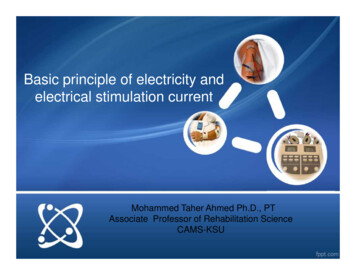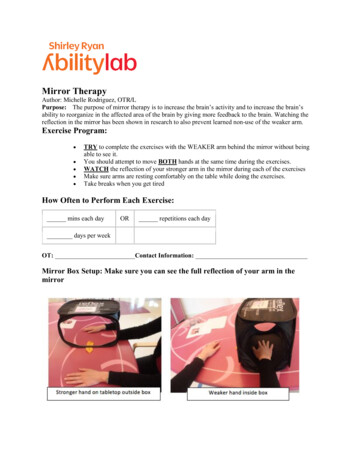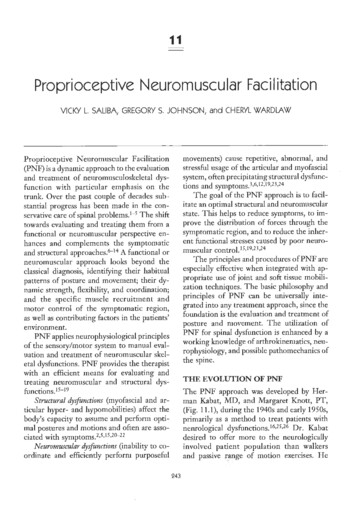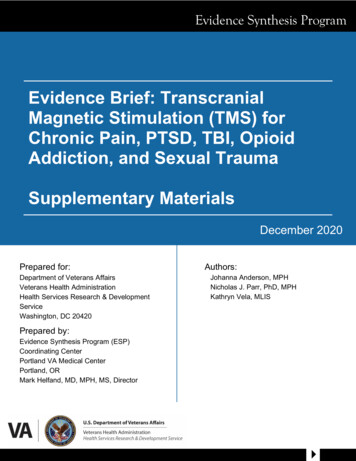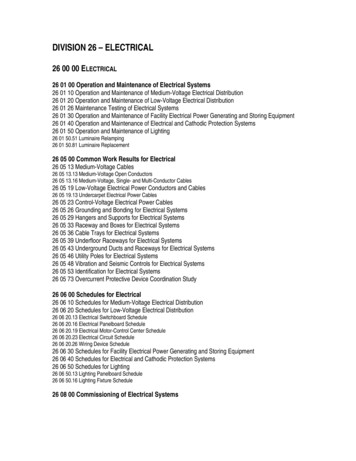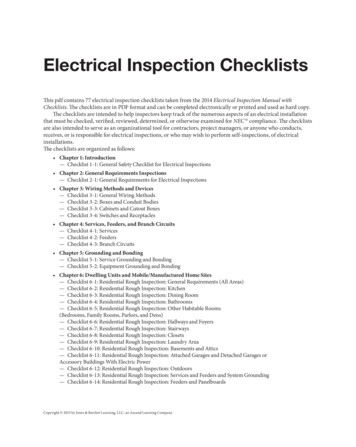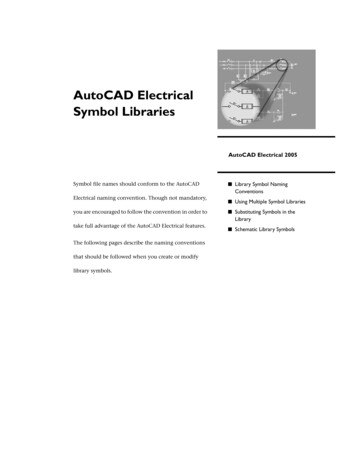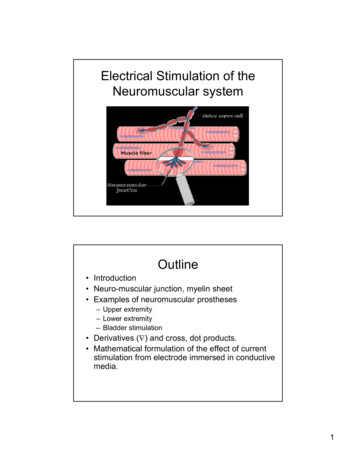
Transcription
Electrical Stimulation of theNeuromuscular systemOutline Introduction Neuro-muscular junction, myelin sheet Examples of neuromuscular prostheses– Upper extremity– Lower extremity– Bladder stimulation Derivatives ( ) and cross, dot products. Mathematical formulation of the effect of currentstimulation from electrode immersed in conductivemedia.1
The neuromuscular junction http://www.youtube.com/watch?v ZscXOvDgCmQ(1min) http://www.youtube.com/watch?v YnVY4Waimwg (3min,McGrawHill book)Neurons, revisited2
Membrane potentialMembrane potential: how does it come about? Charge in each compartment is balanced–Outside the cell, sum of anions sum of cations –[Na ] 2[Ca ] [K ] [Cl-]Inside the cell, sum of anions sum of cations [Na ] 2[Ca ] [K ] [Cl-] [A-]A- are other anions, which are mostly proteinsAnions are impermeant to the membrane3
Identifying parts of a stained neuron:How does a spike ac/homeo/action.htm4
Ion channel statesIon channels,Agonists, antagonists.5
Cable theory, passive conduction.Neurons,Myelin sheath,Synapses6
Chemical synapsesChemical and electrical synapses, voltage clamp7
Passive and active responses, Ion channel statesSaltatory conduction8
Myotactic reflexIntracellular responses during themyotactic reflex9
Reflex as result of sensory neuron stimulation10
References – previous 18 slides.Action potential bioac/homeo/action.htmBooks available gi?db BooksNeuroscience book where I took most figures l bv.View.ShowTOC&rid neurosci.TOC&depth 2Vertebrate motoneuron11
Myelin Tight wrapping of cell membrane around axon Cytoplasm of glial cell is gradually squeezed outas cell wraps around Result is concentric layers of closely apposedmembrane Acts as electrical insulator Huge increase in speed of action potentialtransmissionMyelinated axons, nodes of RanvierMyelin sheath (transversal section)Axon (transversal section)12
Unmyelinated page/en/en.htmMyelin is produced by glia Oligodendrocytes in CNS Schwann cells in PNSvv.carleton.ca/ neil/neural/neuron-a.html13
Nodes of RanvierUnmyelinated axonMyelinated /neurosci/ch3f14.gifSaltatory conduction (Ranvier nodes), and secondderivative of the extracellular potential.14
Electrode-tissue interface Constant current x constant voltagestimulation Tissue damage:– Passive: presence of foreign object (mechanical)– Active: passage of current (electrochemical)Damage to biological tissue Passive: vascular or neural– How to overcome this? Change electrode size, tip geometry, substrate,anchoring Active:– primary (reaction products fromelectrochemistry);– secondary (physiological changes associatedwith neural excitation.15
Effect of waveform Strength-duration curve (obtained empirically):– PW pulsewidth– Ith threshold current– Irh rheobase current, minimum current amplitudeif PW .– Tch chronaxie time PW to excite neuron with2Irh.– Ith Irh (IthTch/PW)Anodic vs cathodic stimulation16
Neuromuscular r prosthesesNervous system injury impairment of motor functions.Motor functions: body functions; limb movement.Objectives of neuroprostheses: restore lost function,increase independence of disabled individuals; reduceeconomic impact of disability.Current neuroprostheses use FES (functional electricalstimulation) to activate motoneurons.Motoneurons: neurons that innervate muscles. Muscles arethe actuators (for the desired function).Current target patients: stroke (750,000/year incidence); SCI(10,000/year incidence, higher prevalence).17
Recruitment propertiesMagnitude of muscular contraction depends on: (1) electrodetype; (2) stimulation waveform shape, time, amplitude; (3)locationof electrode relative to motoneuron.Force modulation can be achieved by: (1) rate modulation (2)recruitment(1) rate modulation: there’s summation of muscularcontraction if high enough frequency is used, but the muscle ismore prone to fatigue. Higher frequency leads to higher (faster)fatigue.(2) recruitment: number of motoneurons stimulated: moreneurons means more muscles.Muscular recruitment through electrical stimulationA: where the electrode is located. If the stimulus intensity is low, this is theonly activated area.B: (white area) if slightly higher current, only muscle 1 would contract.C: possibly higher force exerted by both muscles now.D: everybody is stimulated (both muscles, through activation of bothmotoneuron.MOTONEURONMUSCLE 2CMOTONEURONA BMUSCLE 1D18
Journal of Rehabilitation Research and DevelopmentVol. 38 No. 5, September/October 2001Selectivity of intramuscular stimulating electrodes in the lower limbsRonald J. Triolo, PhD; May Q. Liu, MS; Rudi Kobetic, MS; James P. Uhlir, ://www.vard.org/jour/01/38/5/liu385.htmRecruitment propertiesNonlinearities should be dealt with in the implant: how tomeasure and deal with fatigue.There are high gain regions, and plateau regions (why?).Spillover should also be avoided (they contribute to thenonlinearities)19
Muscle stimulation? With rare exceptions, neuroprosthesesactivate paralyzed neurons at differentlevels of the nervous system:– Spinal cord– Spinal roots– Peripheral nerves– Intramuscular nerve branchesElectrode types Surface:– Skin has high resistance, and high currentneeds to be passed before muscle isactivated. (Large area is stimulated,unpleasant side effects). Implantable:– Epimysial (next slide)– Intramuscular20
A MULTICENTER STUDY OF AN IMPLANTED NEUROPROSTHESISFOR RESTORING HAND GRASP IN TETRAPLEGIAP. Hunter Peckham, PhD*†‡; Michael W. Keith, MD*†‡; Kevin L. Kilgore, PhD*†‡;Julie H. Grill, MS§; Kathy S. Wuolle, OTR/L, CHT§; Geoffrey B. Thrope§; Peter Gorman, MDxx¶;http://www.ifess.org/cdrom target/ifess01/oral1/peckhamPH.htm21
Epimysial versus intramuscular electrodes Epimysial and intramuscular are invasive. Epimysial touches the epimysia (outersheath of the muscle), near the entry pointof the nerve, and is subcutaneouslysecured. Intramuscular: inserted through a needle,the needle is retracted, the barbed tips ofthe “wire” secure it in the muscle.Photograph of two intramuscular electrodeswith helical leads, mounted in hypodermicneedles, on with multistranded lead wire (Top)and with single strand wire 5 61.htmhttp://www.case.edu/groups/ANCL/pages/05/s05 92.gif22
Upper extremity applications Restoring hand grasp and releaseHandmaster (Ness, Israel)Bionic Glove (Prochazka)Freehand system (NeuroControl)23
Neuromuscular Electrical Stimulation Systemshttp://www.nessltd.com/The NESS H200 is a non-invasive, portable devicefor combating and treating the consequences ofbrain damage.This personal system is the outcome of many yearsof development. It is an incorporation andintegration of the most effective state of the artupper limb rehabilitation technologies in a singlesystem. It brings the fruits of the latest clinicallaboratory research and expertise into the homes ofpatients for independent use.24
Urinary Bladder: location and rinaire/intrurin.html25
Urinary Bladder: histologyTutorial Name: NeoplasiaConceptName: In situ carcinomaSlide Name: Bladder Transitional EpitheliumImage Description: Transitional epithelium isfound only in the conducting passages of theurinary system. Note the columnar surface cellswith their large nuclei and prominent nucleoli.These are typical of transitional epithelium.StructuresStructureDescriptionslamina propriaIn the bladder, this isthe rather denseconnective tissuelayer beneath theepithelium.transitional epitheliumWhen the bladder isnot distended (as inthis slide), the line ofswollen cells at thesurface is particularlyevident.Slide 17 Bladder WallThe bladder has transitional epithelium and a thick lamina propria to allow for expansion. You will be thankful forthis on those long days in lab. Bar 250 atomy/histoweb/urinary/renal17.htm26
Urinary Bladder: how does it really look?(right) s files/genitourinary/urinary bladder 4x.jpg(left) http://library.thinkquest.org/15401/images/organs urinarybladder.jpgUrinary Bladder Implant. How would you do vedisease/images/stimulator.jpg27
Implantable bladder rinaire/implant.htmlX-rays show the sphincter contracted before stimulation (a)and loosen during stimulation (b). Also, the graph above showsthat the stimulation efficiency is enhanced by more than 50%with selective stimulation, leading to an average residualvolume of 9%. These results are taken from studies on 8different inaire/implant.html28
Medtronic’s InterStimTM Bladder StimulatorIt measures 2.4 inches (6cm) by 2.2 (5.5cm) by 0.4 inches (1cm),with a weight of 1.5 ounces (42 er?pagename Medtronic/Website/ConditionArticle&ConditionName Urgency-Frequency&Article urinary art deviceSpinal Reflex – what is it?http://137.222.110.150/calnet/LMN/LMN.htm29
Homework 71. Find, in the literature (IEEE, for example) a paper presenting a graph or numbers ofFES results, with stimulus intensity versus force (by the muscle). Copy the figure ormake one (out of the numbers) and explain (one paragraph is enough) what theimplant is for, and what the regions you see are (plateau, high gain, linear, etc).2. Write me an email with the time and day you can come present your project. Itshould be a 20min deal. I would like to see all of you on Monday, but if you can’tmake it, my available days and times are:- Monday, Nov 6th, either between 9am and 3pm, or from 5:15 to 7pm.- Tuesday Nov 7th, afternoon (12pm to 3:30pm)- Wednesday Nov 8th, from 8am to 4pm.You should bring a small presentation on your project. Maximum of 10 slides.Be ready to answer questions. This will be the second phase of you project,and you will be graded for it (not as a homework).30
Electrical Stimulation of theNeuromuscular system: mathematicalderivations and simulationsThe “del” operator (nabla, or )Gradient of p (where p is a scalar field): a vector field!31
Now we want to multiply a vector field v by the gradient.Dot product between vectors a(x,y,z) and b(x,y,z):Cross product between same vectors:1) Dot product between gradient and v(x,y,z):Defined as the DIVERGENCE of v (it’s a scalar!)2) Cross product between gradient and v(x,y,z):Defined as the CURL of v (it’s a vector!)32
Laplacian operator ( 2): divergence of the gradient.Scalar field!Introduction- Restoring function is not immediate in paralysis.Ex. FreeHand (by NeuroControl )- FES (functional electrical stimulation): stimulatethe neuromuscular junction, neuron is stimulatedfirst (less charge needed)- Phrenic nerve stimulation: restore respiration(ventilation)33
Quasi-static formulation of Maxwell’s equationsEquivalence between dielectric and conductive media:It helps to look in static fields (due to point charges) andrelate to fields due to current sources and sinks.34
Now let’s derive the voltage at a point along the axonof a neuron being stimulated by an electrode with amonopolar current source.(See notes)I 1mA35
The Matlab code should be either VERY simple, orunderstandable (if you have never programmed in Matlab in your life).i 1e-3; % current. Assume I 1mAsigma linspace(.12, 1, 4); % conductivity ranger linspace(.001, .05, 100); % axon distance range (in meters)for k 1:4;for j 1:100;v(k,j) gridxlabel('r[cm]');ylabel('V[mV]');title('Plot of Monopole Potential V I/4*\pi*\sigma*r for Typical Brain Conductances');36
Voltage along the axon due to a bipolar source.Current through one electrode has the sameamplitude (but opposite sign) as current through theother electrode.I 1mA,d 0.1mmy 10mmx r37
Now plot both sides of an axon – orthodromic andantidromic – for the bipolar stimulation.38
MONOPOLAR STIMEXTRACELLULAR VALONG THE FIBERANODIC STIMULATIONCATHODIC STIMULATION39
Iel 1mA,rhoe 1 kOhm.m,z 10mm2001000 100V (mV) 200 300 400 500 600 700 800 10 50x along axon (cm)51040
41
Ion channels, Agonists, antagonists. 6 Cable theory, passive conduction. Neurons, Myelin sheath, Synapses. 7 Chemical synapses Chemical and electrical synapses, voltage clamp. 8 Passive and act
